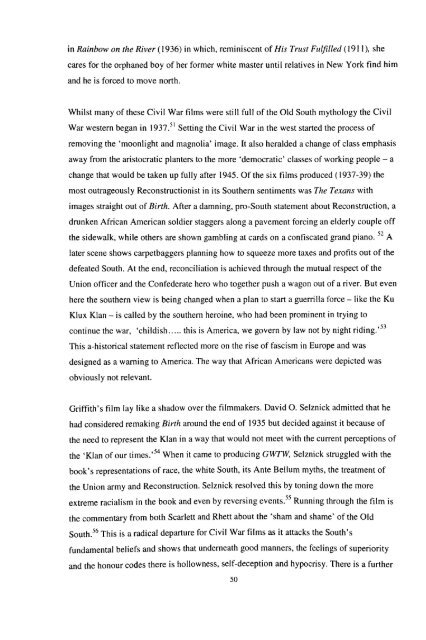Download (3483kB) - Greenwich Academic Literature Archive ...
Download (3483kB) - Greenwich Academic Literature Archive ...
Download (3483kB) - Greenwich Academic Literature Archive ...
- No tags were found...
You also want an ePaper? Increase the reach of your titles
YUMPU automatically turns print PDFs into web optimized ePapers that Google loves.
in Rainbow on the River ( 1936) in which, reminiscent of His Trust Fulfilled (1911), shecares for the orphaned boy of her former white master until relatives in New York find himand he is forced to move north.Whilst many of these Civil War films were still full of the Old South mythology the CivilWar western began in 1937. 51 Setting the Civil War in the west started the process ofremoving the 'moonlight and magnolia' image. It also heralded a change of class emphasisaway from the aristocratic planters to the more 'democratic' classes of working people - achange that would be taken up fully after 1945. Of the six films produced (1937-39) themost outrageously Reconstructionist in its Southern sentiments was The Texans withimages straight out of Birth. After a damning, pro-South statement about Reconstruction, adrunken African American soldier staggers along a pavement forcing an elderly couple offthe sidewalk, while others are shown gambling at cards on a confiscated grand piano. 52 Alater scene shows carpetbaggers planning how to squeeze more taxes and profits out of thedefeated South. At the end, reconciliation is achieved through the mutual respect of theUnion officer and the Confederate hero who together push a wagon out of a river. But evenhere the southern view is being changed when a plan to start a guerrilla force - like the KuKlux Klan - is called by the southern heroine, who had been prominent in trying tocontinue the war, 'childish..... this is America, we govern by law not by night riding.' 53This a-historical statement reflected more on the rise of fascism in Europe and wasdesigned as a warning to America. The way that African Americans were depicted wasobviously not relevant.Griffith's film lay like a shadow over the filmmakers. David O. Selznick admitted that hehad considered remaking Birth around the end of 1935 but decided against it because ofthe need to represent the Klan in a way that would not meet with the current perceptions ofthe 'Klan of our times.' 54 When it came to producing GWTW, Selznick struggled with thebook's representations of race, the white South, its Ante Bellum myths, the treatment ofthe Union army and Reconstruction. Selznick resolved this by toning down the moreextreme racialism in the book and even by reversing events. 55 Running through the film isthe commentary from both Scarlett and Rhett about the 'sham and shame' of the OldSouth. 56 This is a radical departure for Civil War films as it attacks the South'sfundamental beliefs and shows that underneath good manners, the feelings of superiorityand the honour codes there is hollowness, self-deception and hypocrisy. There is a further50
















